Companies now have access to new development and training options thanks to AR and VR technology. One of the advantages is that it allows your clients to interact with your products and services in a genuine, lifelike manner, just as if they were at a physical store. The market for Pc for VR is expected to witness substantial growth over the forecast period. This growth is mainly attributed to the increasing need for training and training facilities in various industries. VR provides a virtual environment to train individuals in a 3D environment. This technology is becoming increasingly popular in various industries and is expected to become an integral part of the training facilities.
VR may be beneficially utilized for internal training in a virtual 3D environment in several industries, such as manufacturing, medical, defense, and utilities, to reduce training costs while also reducing risks and liabilities.
What will you see here:
Why go PC-bound and not solo?
In contrast to a solo VR system, PC for VR provides greater visuals and processing performance. Developers can create a completely immersive VR experience in high-definition using GPUs and CPUs at the cutting edge of technology, allowing VR to reach its full potential.
There’s always the temptation for those who are new in this industry by the less expensive option: standalone virtual reality headsets. Because standalone VR headsets come with their very own processor, RAM, and GPU, but also their own batteries, they wouldn’t need a computer to give a VR experience. They cannot. Although there is still some disagreement concerning PC-bound vs. freestanding VR, several users have verified that spatial tracking is much more accurate on a PC for a VR headset than with a standalone unit, setting aside the upgradeability issue.
If you’re using a PC for VR, you may improve it when your or your headset’s needs change by adding more RAM or updating the graphics card. When dealing with mobile VR, it’s easy to jump on the wrong train and wind up with obsolete equipment or outdated technology because the market moves quickly.
So, without further ado, here is our list of the best PCs for VR.
HP Omen 30L
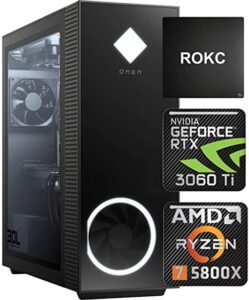
Gaming PCs are ideally suited to VR since they are assets in terms of CPU, RAM, and GPU. This HP Omen 30L is a slim PC with some extremely fast components packed into a thin and attractive chassis with good design features that improve its appearance.
You will pay a reasonable price for this PC because it is a consumer and market PC. We chose the AMD Ryzen 5 processor, which has six cores and 16GB of RAM. It comes with a fast PCIe SSD and a large 1TB hard drive, giving you enough space for VR development and apps. Other combinations, such as a 2TB SSD with a 2TB HDD with 64 GB RAM, are available at retail.
Its semi-transparent tempered glass side panel highlights these characteristics while also allowing quick access to the electronics without the use of tools. It comes with a variety of USB connections, including USB 3.2 Gen 2 at 10Gbps, making it simple to connect your VR positional sensors. However, the USB-C connector is located at the rear, which is a disappointment.
Lenovo ThinkStation P620 PC for VR
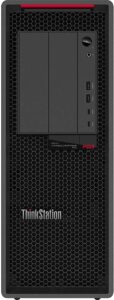
Lenovo’s ThinkStation P620 is a little workplace that is a bit smaller than an ATX container, but it has a versatile design that will keep you working for years. On the front panel, there are two USB-C ports for connecting your VR headset, and six USB-A connectors on the rear.
The Lenovo ThinkStation P620 is a tiny workplace with a versatile design that will keep you working for years. The front panel has two USB-C ports for your VR headset, while the rear panel has six USB-A connectors.
The CPU has eight ram channels, allowing it to accommodate up to 512 GB of memory space distributed across eight 64 GB DIMMs. For a nominal fee, you may add more capacity to your purchase, such as a larger 2TB PCIe M.2 SSD. It can contain up to five SATA hard drives, which is a lot if you load it with 10TB discs.
The cheapest option on Lenovo’s website features only 256GB of SSD storage and a base Quadro P620 with 2GB of VRAM, making it unsuitable for VR usage. As a result, the more costly option (part number 30E1S0FG00) had to be chosen, which updated the Ryzen Pro to a 16-core model and included an NVIDIA Quadro RTX 4000 video card with eight gigabytes of RAM. As a consequence, SSD storage capacity has increased to 1TB, which is great news for VR users.
What could possibly be wrong with this system? Timeliness is important. Lenovo has been hampered by the industry-wide components scarcity, and your custom-built system might take weeks to arrive. So, if you really want one with the correct GPU for VR at a store, go for it.
Alienware Aurora R12 and R11 PC for VR
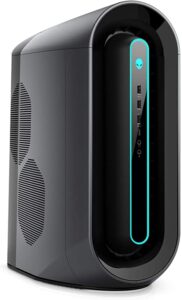
The Alienware Aurora series ranks first in terms of appearance. As it forgoes the typical “square box design with a glass side panel” of other gaming PCs in favor of a spaceship-inspired design. Its futuristic style will appeal to all those who work in VR design.
Alienware decided to keep the same 11700F CPU with a cooling system and the same powerful Nvidia RTX3080 graphics card. This also comes with 10GB of VRAM when updating its Intel i7 offering. The R12’s memory was increased from 16 GB to 64 GB. Moreover, storage was increased from a 512GB SSD + 1TB HDD to a 1TB SSD plus a 2TB HDD. This is all for the same original retail price.
The R11 is more likely to be available in stores than the R12. However, the designs for both are the same.
You might be asking why we didn’t have included the Alienware R13/R14. We have no right to examine the R13 or R14. However, the R12 from last year continues to receive positive feedback. Therefore we’re thinking Alienware will continue to support both product offerings for some time. Expect the cost of the R11/R12 to drop as dealers push for sales of the upcoming R13/R14 versions.
If You Want Alienware R12
If You Want Alienware R11
CyberPowerPC Gamer Xtreme VR Gaming PC (GXiVR8060A11)
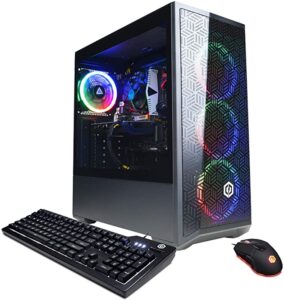
When money is scarce, it may be tempting to construct your own systems. However owing to the lower costs producers can receive on GPUs, it is more cost-efficient to hunt for pre-built workstations. From the casing to the power supply, as well as RAM and GPU, it is a system builder that employs brand-name parts. We feel this is a strong contender for this category because it is a best seller with the
This gaming PC’s casing is standard black, with RGB LEDs and tempered glass sides. This system comes with an 8GB Gigabyte b560 ds3h ac motherboard, a six-core Intel i5 11400F CPU, and an NVIDIA GeForce RTX 2060 graphics card with 6GB of video memory.
In terms of ports, there are six ports. They are USB 3.1 ports, two USB 2.0, a Gigabit Ethernet wired network connection, and onboard “AC” Wi-Fi. Obviously, a keyboard and a mouse are also provided. You may want to consider upgrading to 16 GB RAM if you want to take advantage of dual-channel speeds.
Zotac Magnus One PC for VR
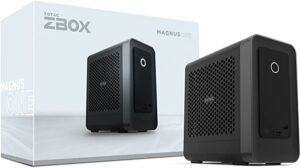
VR requires a high-end graphics card, which restricts the size of your PC owing to GPU needs. Regardless, Zotac has demonstrated that we wouldn’t need a massive PC machine to experience VR.
Its Magnus system is roughly the size of a shoebox and is slanted at a 90-degree angle. This 8.3-liter design has a Core i7-10700 CPU and GeForce RTX 3070 LHR graphics card, as well as two SSD ports and a 2.5-inch bay. We chose a machine with 16GB DDR4 RAM, 512GB SSD, and a 1TB hard drive. It’s also accessible in a barebones version, which means you’ll have to add your own RAM, storage, and os.
The PC’s compact size and several vent holes on the side give it a fashionable and unusual appearance. Furthermore, without the gaudy led lighting seen on many gaming PCs, its black chassis looks extremely gorgeous with two USB connections in the front and six in the rear, attaching your VR headset and sensors should be a breeze.
It offers a wired 2.5 Gbps Ethernet and WiFi 6 connection, with two antennae positioned directly on the top rear of the chassis. You may quickly remove the side panels after cutting the top cover to replace the electronics in the future.
What’s not to enjoy about a top-notch connection, a strong CPU, and a powerful GPU? That’s what it is: noise. It’s a loud machine. Multiple fans spin at the same time to remove the heat generated by the system’s components, making them audible via vent holes. If you’re using headphones, though, the argument is irrelevant. They are compatible with the Oculus Quest and Quest 2 headsets; simply insert the headphones into the audio port.
Conclusion
Building your own PC is not the ideal solution in a commercial setting. It’s time-consuming, and it can’t be scaled beyond one without adding to your IT staff’s workload. The VR requirements are well within the capabilities of many prepared PCs, both for gaming and for graphics workstations. To get started, you’ll need a powerful steady for the past processor and one of the greatest graphics cards accessible.
There should also be sufficient ports to connect in the VR headset and any motion sensors that are required -although more are permitted, many experts advise keeping to three. As a result, gaming PCs with powerful graphics cards, as well as workstations, are appropriate for professional VR use. Technical specifications vary depending on the VR headset you wish to use. However, One premium VR headset, the HP Reverb G2, requires an Intel Core i5, Core i7, with 8 GB of RAM or more, with 16 GB of RAM suggested. You’ll also need a DisplayPort 1.3 video out port and USB 3.0 type C connections.
















